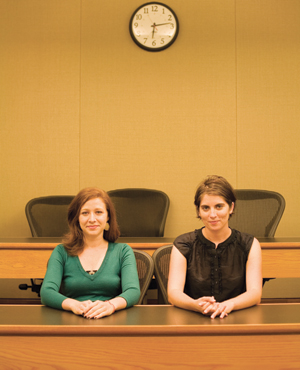Stanford Prison Forum
A large part of what brought me to California was its prisons. As a lifelong East Coaster, I had a hard time fathoming the anomaly of Golden State incarceration. How could it be that such a progressive state clung to the harshest “three strikes” law in the nation? How could one state’s prison population rival the population of all the federal prisons combined? In choosing between law schools, Stanford seemed to me to be the ideal place to study California’s prisons from the inside out.

In my first year at SLS, I met Sara Mayeux ’10 (PhD ’15), a fellow law student also pursuing a degree in history. Over coffee we discovered a shared interest in the interdisciplinary nature of the California prison crisis. The intersections of mass incarceration with education are well-known and decried. It has been said that prison officials plan the construction of new facilities by analyzing third-grade reading levels. But the connections don’t stop there: We wanted to explore the relationship of prisons to medical care and health insurance, the roots of American prisons in slavery, their importance to the U.S. and global economy, and their place in our popular imagination.
Sara and I decided that to study the prison crisis as a system, we would need more than a formal legal education. Luckily, at Stanford we have access to an array of graduate schools and programs, all comprising students at the top of their fields. We soon connected with students from the medical, business, and education schools, the sociology program, and the modern thought and literature program. We then put together an application for a Student Projects for Intellectual Community Enhancement—commonly known as SPICE—grant.
Funded by the vice provost for graduate education, SPICE grants provide students with the resources to expand the intellectual community of their graduate departments. The main requirement for SPICE is that the proposed project engage students across disciplines and foster cross-disciplinary communication. We pitched ours, now named the Stanford Prison Forum (or SPF), to the SPICE committee and were thrilled when the proposal was funded last spring.
As our plans for the fledgling Stanford Prison Forum are still in the works, we aim to start small and then widen our net. This winter, SPF will host a series of workshops on the U.S. prison system, with a special emphasis on California. Thanks to the new quarter system, we can and will invite students from all graduate programs to participate and lend their respective expertise to the problem of prisons. The workshops will take place under the guidance of Stanford Criminal Justice Center faculty co-directors Robert Weisberg ’79, Edwin E. Huddleson, Jr. Professor of Law, and Joan Petersilia, Adelbert H. Sweet Professor of Law, and executive director, Debbie Mukamal.
We are currently in talks with the Prison University Project (PUP) about the possibility of holding the workshop series at San Quentin, California’s oldest state prison. The Prison University Project (www.prisonuniversityproject.org) began after Congress passed legislation in 1994 prohibiting people pursuing education inside prisons from receiving Pell Grants. Through fundraising and volunteer efforts PUP filled the gap left by Pell and now provides college-level courses to approximately 200 men at San Quentin. We plan to have Stanford students working alongside PUP students, to read about and analyze the intersections of mass incarceration with race, poverty, gender, health care, and education. The culmination of the workshop series will be a collection of papers, written collaboratively by Stanford and PUP students. Sara Mayeux will then post the finished papers on her blog, prisonlaw.wordpress.com, which has received national recognition from popular bloggers including Andrew Sullivan and Ta-Nehisi Coates of The Atlantic and Adam Serwer of The American Prospect.
And on campus, Stanford Prison Forum is sponsoring speakers and events that resonate with our central purpose, beginning with a panel at Shaking the Foundations: The West Coast Conference on Progressive Lawyering, held in October. Organized by Law Students for Reproductive Justice, the panel brought together a litigator, an assemblywoman, a professor, and a gynecologist to discuss the reproductive rights of female prisoners.
As our goal is to engage people across communities in the dialogue on prisons, we are looking to increase participation beyond the limits of the Stanford campus. To this end, we are forging relationships with incarceration-focused organizations outside of SLS, including Free at Last, an East Palo Alto organization that provides re-entry services for parolees, and All of Us or None, an initiative of former prisoners dedicated to fighting discrimination against people with criminal convictions (www.freeatlast.org; www.allofusornone.org).
California’s prisons are in crisis. With gymnasiums housing inmates, beds triple-bunked, and the entire system under federal receivership—it’s time to question large-scale incarceration. My hope is that the Stanford Prison Forum will prove a useful vehicle for students interested in engaging with this task.
1 Response to “Stanford Prison Forum”
Comments are closed.

celine
The prison system in general is completely broken, and in my eyes growing increasingly unfixable for a lack of more eloquent words…